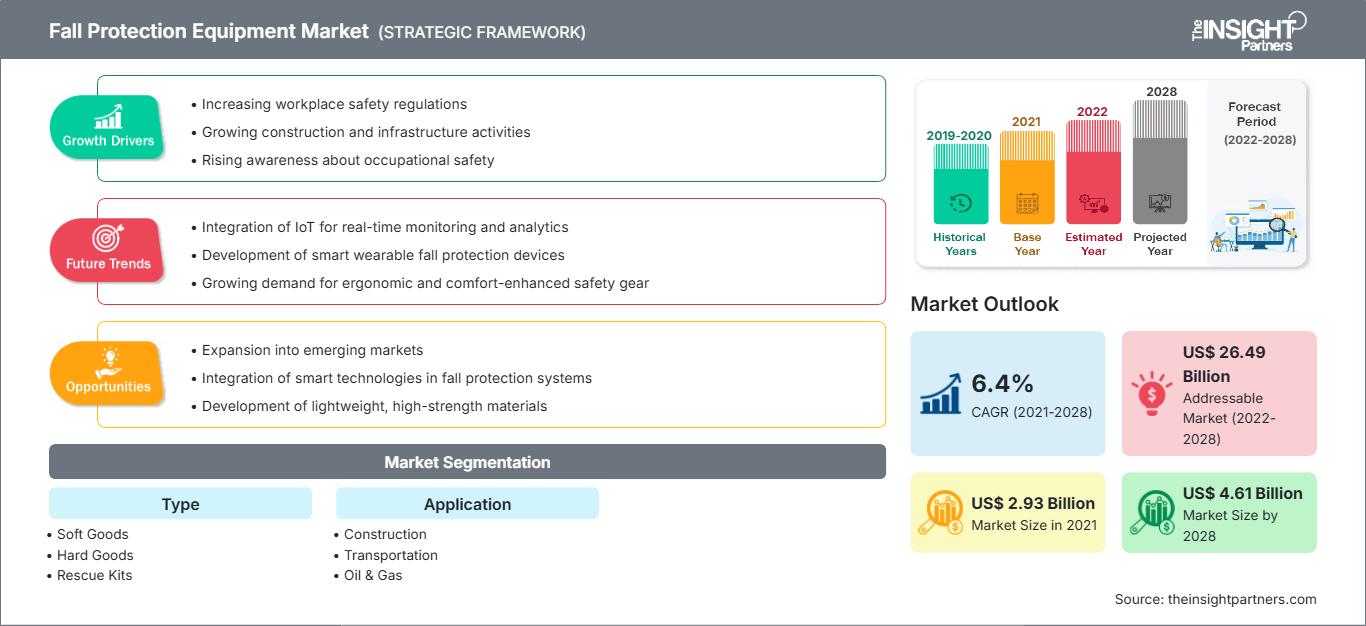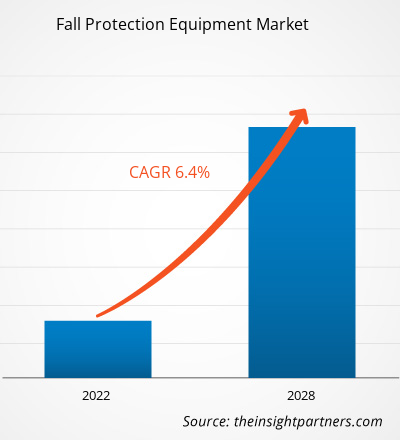预计防坠落设备市场规模将从 2021 年的 29.3486 亿美元增长到 2028 年的 46.0661 亿美元;预计 2021 年至 2028 年的复合年增长率为 6.4%。
发达国家和发展中国家的快速工业化是推动市场扩张的主要因素之一。由于各种制造、采矿和其他工业场所缺乏足够的安全程序,职业危害日益普遍。与其他国家相比,美国更加关注工人的安全和健康,这推动了防坠落设备在该国的采用。为了监督安全规范和程序,该国成立了一些机构,例如职业安全与健康管理局 (OSHA) 和美国国家标准协会 (ANSI)。 OSHA 是一家健康与安全法规及合规组织,为员工提供 10 小时和 30 小时的 OSHA 法规和标准意识培训,涵盖与工作场所各类职业相关的 OSHA 法规和标准。然而,欧洲和亚洲对工作场所安全实践的日益重视以及政府对工人安全法规的不断完善,推动了市场的发展。由于人口增长,印度和中国等亚洲国家的建筑活动不断增加以及石油和天然气行业的蓬勃发展,预计将在预测期内推动市场增长。城镇化进程加快以及石油和天然气行业的增长是支持中东和非洲 (MEA) 和南美 (SAM) 地区防坠落设备市场增长的关键因素之一。
自定义此报告以满足您的要求
您将免费获得任何报告的定制,包括本报告的部分内容,或国家级分析、Excel 数据包,以及为初创企业和大学提供超值优惠和折扣
防坠落设备市场: 战略洞察

- 获取本报告的主要市场趋势。这个免费样本将包括数据分析,从市场趋势到估计和预测。
您将免费获得任何报告的定制,包括本报告的部分内容,或国家级分析、Excel 数据包,以及为初创企业和大学提供超值优惠和折扣
防坠落设备市场: 战略洞察

- 获取本报告的主要市场趋势。这个免费样本将包括数据分析,从市场趋势到估计和预测。
2021 年,COVID-19 疫情在多个国家持续造成不利影响。生产工厂停工或业务运营受限、封锁和旅行限制阻碍了防坠落设备的生产和供应链。由于政府实施的封锁和建筑项目数量减少,2020 年对防坠落设备的需求略有下降。然而,在 2021 年,由于建筑活动、石油和天然气勘探以及电信项目的增加,对防坠落设备的需求有所增加,以确保员工安全。电子商务业务也有助于促进建筑行业对防坠落设备的需求。
防坠落设备市场洞察 建筑活动增加
全球建筑活动的增加是推动防坠落设备市场的主要因素。随着印度和中国等亚洲国家人口的显著增长,这些国家对商业和住宅空间的需求也在不断扩大。由于信贷约束日益加深,全球经济目前正经历严重放缓,导致世界各国经济体未能实现其发展目标。在当前形势下,基础设施仍然是弥补发展差距的首要任务,因为它被视为万能的,能够帮助经济体摆脱金融动荡。世界各国政府都在向物质和社会基础设施投入资金,以创造就业机会来增加对产品和服务的需求。
基于类型的市场洞察
根据类型,坠落防护设备市场可细分为软质产品、硬质产品、救援套件、安全带、全身式安全带等。硬质产品领域是领先的领域,因为它提供了更高的安全性。此外,该领域的不断创新有望推动市场增长。然而,所有工业用户对全身式安全带系统日益增长的需求,正推动该领域以最高的复合年增长率增长。
基于应用的市场洞察
就应用而言,防坠落设备市场分为建筑、石油和天然气、运输、能源和公用事业以及电信。为了确保活动的有效进行并维护工人的安全,每个行业都需要在其设施中配备防坠落设备。2020 年,建筑行业占据了最大的市场份额。
防坠落设备市场的参与者采用合并、收购和市场举措等策略来保持其市场地位。以下列出了一些主要参与者的进展:
- 2021 年 5 月,Pure Safety Group 将其高空安全品牌系列——Stronghold by PSG、Ty-Flt、Checkmate 和 HART——并入 Guardian 旗下。此次扩张使 Guardian 成为全球最大的独立坠落防护和预防品牌。
- 3M Fall Protection 发明了悬挂式创伤安全带,并于 2021 年 3 月底将该系统应用于所有经 ANSI 和 CSA 认证的 3M DBI SALA 安全带。
防坠落设备市场
The Insight Partners 的分析师已详尽阐述了预测期内影响防坠落设备市场的区域趋势和因素。本节还探讨了北美、欧洲、亚太地区、中东和非洲以及南美和中美洲的防坠落设备市场细分和地域分布。
防坠落设备市场报告范围
| 报告属性 | 细节 |
|---|---|
| 市场规模 2021 | US$ 2.93 Billion |
| 市场规模 2028 | US$ 4.61 Billion |
| 全球复合年增长率 (2021 - 2028) | 6.4% |
| 历史数据 | 2019-2020 |
| 预测期 | 2022-2028 |
| 涵盖的领域 |
By 类型
|
| 覆盖地区和国家 | 北美
|
| 市场领导者和主要公司简介 |
|
防坠落设备市场参与者密度:了解其对业务动态的影响
防坠落设备市场正在快速增长,这得益于终端用户需求的不断增长,而这些需求的驱动因素包括消费者偏好的演变、技术进步以及对产品优势的认知度的提升。随着需求的增长,企业正在扩展产品线,不断创新以满足消费者需求,并抓住新兴趋势,从而进一步推动市场增长。

- 获取 防坠落设备市场 主要参与者概述
- 软质商品
- 硬质商品
- 救援套件
- 安全带
- 全身式安全带
- 其他
按应用
- 建筑
- 运输
- 石油和天然气
- 采矿
- 能源和公用事业
- 电信
- 其他
按地理位置
北部美洲
- 美国
- 加拿大
- 墨西哥
欧洲
- 法国
- 德国
- 意大利
- 英国
- 俄罗斯
- 欧洲其他地区
亚太地区 (APAC)
- 中国
- 印度
- 韩国
- 日本
- 澳大利亚
- 亚太地区其他地区
中东和非洲 (MEA)
- 南非
- 沙特阿拉伯
- 阿联酋
- MEA 其他地区
南美洲 (SAM)
- 巴西
- 阿根廷
- SAM 其他地区
公司简介
- 3M
- Falltech
- French Creek Production
- Frontline
- Guardian Fall Protection
- Kee Safety
- KwikSafety
- MSA Safety Incorporated
- Honeywell International Inc.
- Tritech Fall Protection
- 历史分析(2 年)、基准年、预测(7 年)及复合年增长率
- PEST和SWOT分析
- 市场规模、价值/数量 - 全球、区域、国家
- 行业和竞争格局
- Excel 数据集
近期报告
客户评价
购买理由
- 明智的决策
- 了解市场动态
- 竞争分析
- 客户洞察
- 市场预测
- 风险规避
- 战略规划
- 投资论证
- 识别新兴市场
- 优化营销策略
- 提升运营效率
- 顺应监管趋势




















 获取免费样品 - 防坠落设备市场
获取免费样品 - 防坠落设备市场